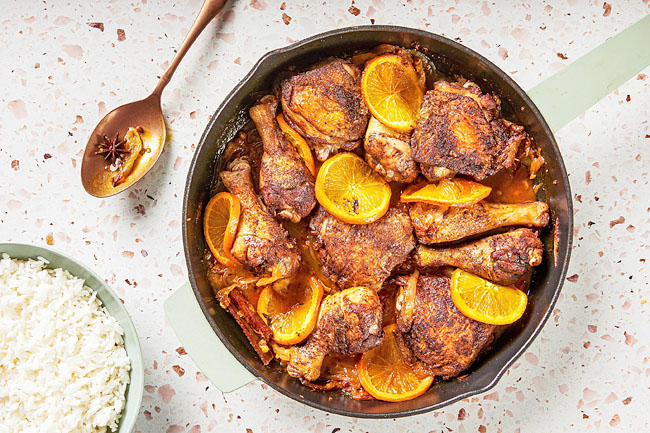Ann Maloney
THE WASHINGTON POST – I’m all in favour of substitutions when cooking and realise that sometimes because of dietary issues or to save money or cut waste, it is essential to use this in place of that. If you can, however, I strongly encourage you to use Sichuan peppercorns for this Orange Sichuan Pepper Chicken from Sarah Tiong’s Modern Asian cookbook.
When I asked Tiong why the peppercorn was key to her interpretation of this popular Chinese dish, she explained via e-mail from her home in Australia: “It adds a beautiful balance of pepperiness and floral notes to the dish. It’s perfectly paired with aromatic and warm spices like cinnamon, star anise and clove.”
Each of these spices are at play here, and she uses all of them whole, scooping up the small peppercorns with her chicken and sauce.
“I love biting into these little bombs of flavour in the sauce,” she said of the peppercorns. “It adds texture and excitement.”
By excitement, she is referring to the numbing or anaesthetic effect on the tongue, which is believed to be caused by the hydroxy-alpha sanshool molecules in Sichuan peppercorns – which are not actually peppercorns at all but are the dried citrus berries of the prickly ash tree. (I tried the dish with the black pepper and it was still delicious, but I did miss the distinctive Sichuan flavour).

Tiong advises toasting the peppercorns in a dry pan over medium heat or slipping them into a hot oven for a few minutes to activate the aroma and boost the flavour. Then, if leaving them whole seems too adventurous, grind them in a spice mill or a mortar and pestle.
Use them in this dish and then keep going: Make stir fries, such as kung pao chicken, season sauces for other proteins or vegetables. Make your own five-spice powder or Sichuan chilli oil.
“My other favourite way to use the toasted peppercorns is to grind them with rock salt,” said Tiong, who works as a private chef while also running a pop-up market stall in Sydney. “This is a fantastic seasoning on fried foods. Try it on fried and battered squid, chicken or even sweet potato.”
The orange chicken dish is a good example of Tiong’s approach to food. She is Chinese Malaysian, but was born in Australia and grew up in the suburbs and near the beaches of Sydney. Along with cultural heritage, time and place – and her mother – have had a huge impact on her cooking, she said.
The cookbook includes classics like roast chicken dinners, and duck and pappardelle, “all with a bit of an Asian mum’s twist”, she said, adding that the cookbook is a tribute to her Chinese Malaysian mother, Christine, who died shortly after Tiong’s last appearance on MasterChef Australia in 2020. Tiong’s mother, who grew up in a small village by the river in Sarawak, Malaysia, immigrated to Australia and raised two children while running her own business, working seven days a week most of her life.
With her children clamouring for roast suppers and lasagna, the working mother taught herself to cook these dishes, but still leaned heavily on her Asian pantry, and that fusion of flavours can be felt throughout the cookbook.
“Just because I add miso to my meatballs or soy sauce to my stroganoff doesn’t mean it is any less delicious than what is widely accepted as tradition,” Tiong said, adding that food and identity are inextricably linked, but change over time with life experience. She sees food as a “conversation starter; the best way to break down walls and connect with people”.
ORANGE-SICHUAN PEPPER CHICKEN
The orange chicken found in many takeout Chinese restaurants is a popular dish, but too often the chicken is fried in a doughy matter and the sauce is “sickly sweet”, Sarah Tiong wrote in her cookbook, Modern Asian.
INGREDIENTS
Four to six skin-on, bone-in chicken thighs and drumsticks
One teaspoon fine salt, divided, plus more as needed
Two teaspoons five-spice powder
Two tablespoons plus two teaspoons neutral oil, such as canola
One medium yellow onion, halved and thinly sliced
One teaspoon grated fresh ginger
Eight cloves garlic, minced or finely grated
One tablespoon Sichuan peppercorns, toasted and ground using a mortar and pestle
Two whole star anise
One stick cinnamon
Generous half cup fresh orange juice
Three tablespoons chilli sauce
One large orange, thinly sliced
Steamed rice, for serving (optional)
DIRECTIONS
Position a rack in the middle of the oven and preheat to 350 degrees.
Pat the chicken dry and sprinkle it with half teaspoon salt and the five-spice powder and massage the seasonings into the meat.
In a large, oven-safe frying pan or skillet over medium-high heat, heat the oil until it shimmers. Add the chicken, skin side down, and cook without moving it until it turns golden brown, about five minutes. (The chicken will splatter, so a screen is useful here). Transfer the chicken to a plate, leaving any fat in the pan.
Reduce the heat to medium, add the onion, ginger and garlic and cook, stirring frequently, two to three minutes. Add the remaining salt, Sichuan pepper, star anise and cinnamon stick and cook, stirring, until fragrant, about one minute. Stir in the orange juice and chilli sauce until fully incorporated and bring to a simmer.
Return the chicken to the skillet, arranging it skin-side up in the sauce, then nestle the orange slices around the meat. Transfer the pan to the oven and roast until the sauce is reduced and a thermometer inserted in the thickest part of the meat (away from the bone) registers at least 165 degrees, about 20 minutes.
Transfer the chicken to a platter and spoon the orange slices, spices and sauce over the pieces. Serve with rice, if desired.






